SUMMARY
This is AI generated summarization, which may have errors. For context, always refer to the full article.
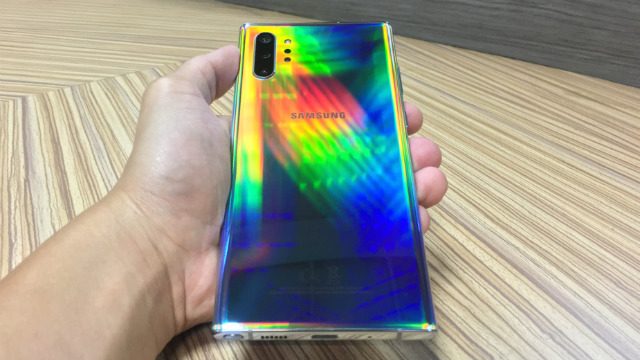
If you’re in the market for an ultra-expensive smartphone, there’s a feeling that it’s become a two-way race again this coming holiday season. On one hand, you have Apple’s iPhones, and on the other, you have Samsung with its flagship Galaxy phones from the S and Note line.
It’s the Note 10+ that we’re focusing on today, having been released in August – and we’ve had ample time since with it.
And it’s still a beauty, to the surprise of but a few. Samsung’s edge-less Infinity display – something we’ve seen since the 2017’s S8 – remains gorgeous to look at, as well as the sturdy polished aluminum frame and glass back.
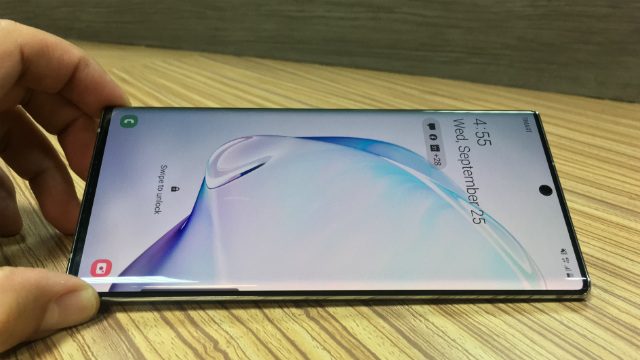
It hasn’t really changed much in terms of construction, so if you’re looking for something that feels incredibly new in the hand, you’re not going to get it with the Note 10+. What you will get though is a premium phone through and through, with the name, the lineage, and the relative consistency honed through through the years.
Make no mistake about it though: the Note 10+ is a luxury, and not a necessity in this age of cheap, good P20,000 phones. Anyone who’s considering to buy one should just know that you no longer have to spend so much to get a solid phone that runs your apps, your games, whatnot.
With the Note 10+, what you’re really paying for here are the premium build, the beautiful glass construction, the premium design, a significant bezel reduction from the Note 9, and well, the name as well.
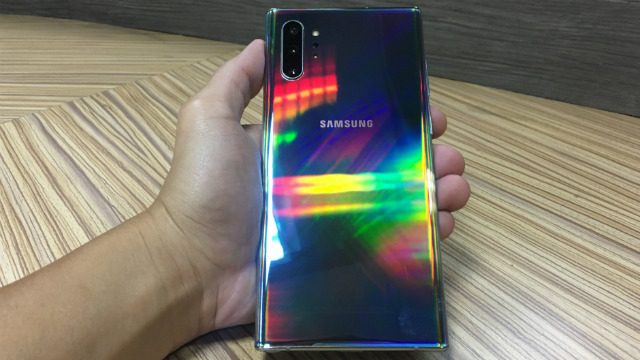
Not everyone needs that; but most everyone, give them time with the Note 10+, and it’s hard not to want one. It’s a shiny, shiny thing, and we don’t really always outgrow our natural predilection towards shiny objects, do we?
Personally, I love it. If P50,000 is nothing to you, there are few other phones I’d recommend. OPPO is getting there, and made headway with the Reno 10x Zoom, but still have a ways to really get that kind of equity among consumers. Huawei has that whole US thing they’ve got to sort out (a shame, because they had Samsung shaking for a hot minute there). And as for the iPhones, well, they can be just as desirable as a flagship Samsung, can’t they?
What I liked
The Note 10+ is light for its size. It’s the biggest Note ever, with a 6.8-inch display, but it only weighs 196 grams. Last year’s 6.4-inch Note 9 weighs 201 grams. That’s a considerable display size increase while reducing the weight.
The standard Note 10 is even lighter: 168 grams with a 6.4-inch display. Along with the 5.7-inch Note 3 which weighs the same, the 10 is the lightest-ever Note. Last year’s Huawei Mate 20 Pro – a direct competitor of the Note series – has a 6.4-inch screen but weighs 189 grams. The newly announced Mate 30 Pro has a 6.5-inch screen and weighs 198 grams. The Reno 10x Zoom is the literal heavyweight here, weighing 210 grams with a 6.6-inch display.
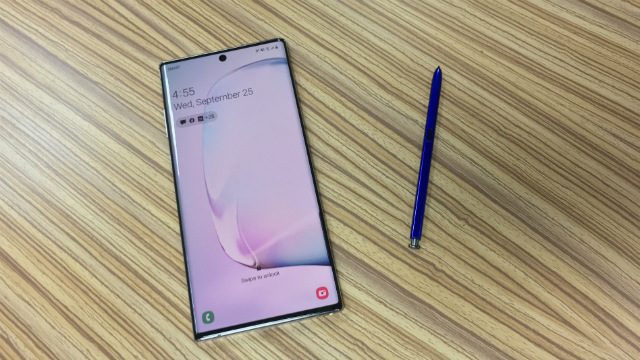
Samsung isn’t marketing the Note 10’s weight that much, but it’s really one of its characteristics that I like.
Another much-improved aspect: the screen-to-body ratio. The Note 8 has an 83.2% screen-to-body ratio while the Note 9 is at a roughly similar 83.4%. But the Note 10+? 91%. A huge jump for the series, and flat out makes the older Notes look really dated. This amount of screen is a big reason why the 10 looks so beautiful.
You don’t even need percentage numbers to tell the story. Just look at the photos. The top and bottom bezels have been chopped off, and I think that allows the curved screen to look even better.
I also like the punch-hole camera being in the middle more than the S10’s corner placement.
And maybe for the first time, I’m actually enjoying using a phone in split-screen mode because of all that real estate, and the hitchless performance even with the 2 separate windows open.
The stereo speakers are pretty good, and appears to create a more satisfying soundstage than most standard phones. It’s loud but still sounds composed. And if you want to tell your friends something cool, tell them that the screen itself doubles as a speaker. It’s good for gaming as it’ll still sound loud and good even if you cover the other speaker on the bottom with your hand.
It’s really good enough that you can survive without a nice Bluetooth speaker for a stretch.
The 4,300 mAh battery has been resilient too, fulfilling its promise of day-long regular use. With fast-charging, charge an empty phone for 50 minutes to an hour, and you’re set for the day. Do note that the charger you get with the Note 10+ is the 25-watt fast-charger. The 45-watt fast-charger, the fastest that the phone can handle, is a separate purchase, priced internationally at $50.
And oh, it has 12GB of RAM, so you can run…Crysis? Maybe?
What I don’t like
So far there’s one big thing that was a little bit jarring for me: powering off the phone. To do so, you need to press the power button and the lower button on the volume rocker simultaneously. It’s probably an annoyance that one could get used to eventually but why – after years and years of using just one button to power down – do I have to press two buttons now just to power down?
All the buttons are on the same side too so you basically need to get a good grip to power the phone down using your index and middle finger, or your other hand.
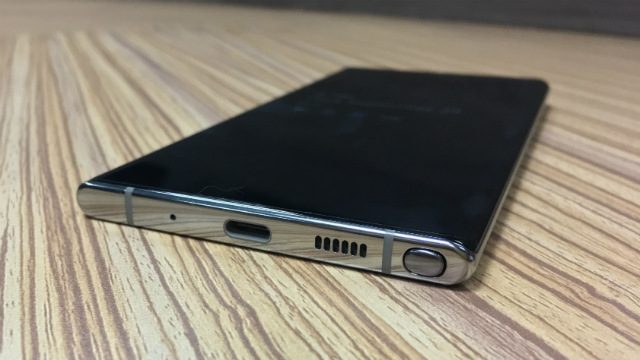
Just long-pressing the power button summons Bixby.
I’m also not a fan of phones that have both the power and volume rockers on one side. It makes it harder to take a screenshot, and I regularly take screenshots of my phone. It’s easier if the power button and rockers are on opposite sides.
It’s also the first Note to not have a traditional headphone jack. And you’ll have to buy a headphone jack adapter for its USB-C port because Samsung didn’t include one in the package, like Huawei and Apple with their recent flagships. To be fair, Samsung has included some nice AKG earphones in the package.
The phone’s back could be a bit of a fingerprint magnet too.
Key spec changes from the Note 9 to Note 10+
- HDR to HDR 10+
- 4K 60 fps without image stabilization to 4K 60 fps with image stabilization
- Wide, tele cameras to wide, tele, ultrawide, and depth-of-field cameras
- 8 MP selfie to 12 MP selfie with ultrawide mode
- 1440p video selfie to 4k video selfie
- 15w fast charging to 45w fast charging
- Live image focus bokeh to live video focus bokeh
- Improved stabilization
- Improved video editing app
- Improved linking to Windows
- Now has an in-display fingerprint scanner
- New augmented reality tricks
- New S Pen tricks: zooming in, photo browsing, volume change gestures
Overall, it’s just simply more robust on the camera side of things. There are lots of additions but my favorite are the new ultrawide cameras on both the back and the front, because these are just very useful in taking group photos, landscape shots, and generally when shooting in any cramped area. In general, the shots have quite the natural tone to them – not overly saturated, good colors and dynamic range.
With all the new tricks of the S Pen, perhaps the most useful application is video editing. It’s just so much easier trying to edit a video with the accuracy that a stylus gives you rather than trying to edit with your mere fingers.
Speaking of the S Pen tricks though, having tried the new air gestures, I don’t really see myself changing the volume or browsing photos waving the stylus around. It’s more effort than just merely swiping, and you need some time to learn it. You press the button, do a gesture (say, move the pen left or right to go to the next photo), and then release the button. It’s not 100% pick-up-and-play. The best trick remains the ability to use the stylus as a shutter remote, a feature that was also available last year.
It’s also great to see that 4K 60 fps video now gets image stabilization because if you’re shooting at that quality, camera shake is going to stand out that much more. The phone’s image stabilization is pretty great, thankfully.
It’s fantastic, and worth the money for those able to afford a luxury phone – if a bit conservative with the changes. If you’re at this price point, look at the iPhone 11 Pro and, if you believe you can live without Google apps, the Huawei Mate 30 Pro too. We’ll have a closer look at those two soon. But just at a glance, value-for-money-wise, the Note 10+ appears to be on par with the iPhone 11 Pro overall, with the Huawei Mate 30 Pro having a few more impressive-sounding hardware choices and features than those two. – Rappler.com
(Disclaimer: Samsung lent a review unit for the purpose of this article.)
Get the latest Samsung smartphones with this Shopee voucher code.
Add a comment
How does this make you feel?
There are no comments yet. Add your comment to start the conversation.